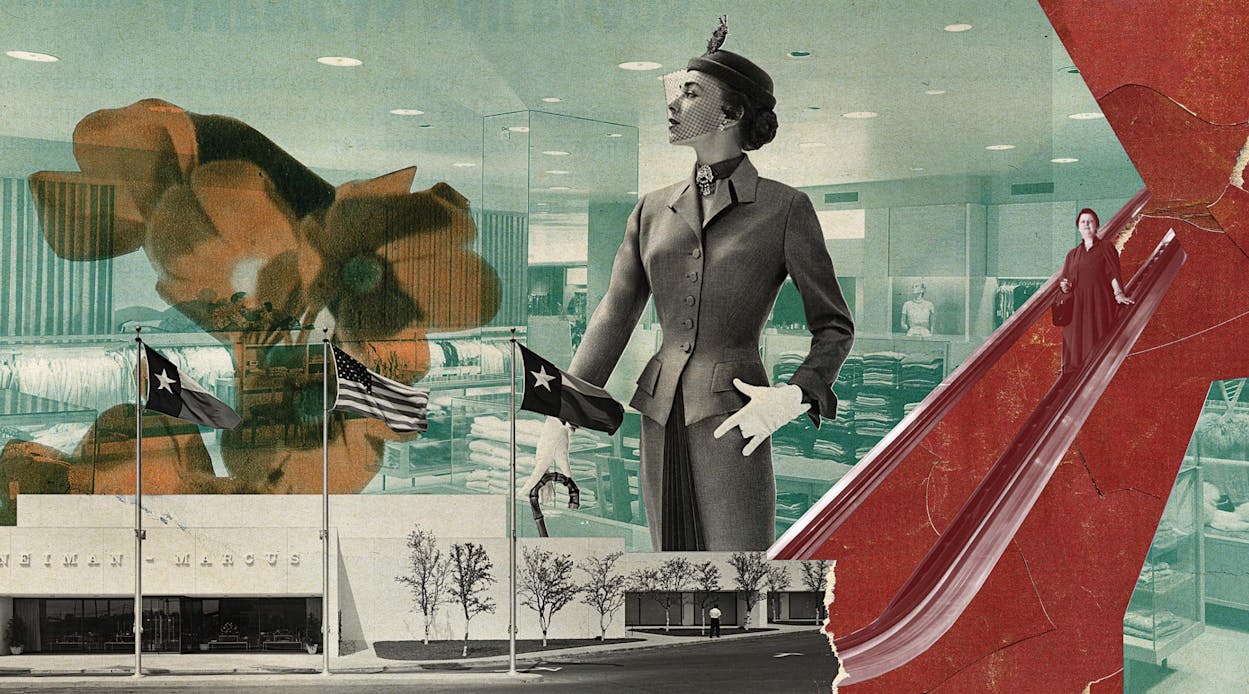When I was in my early teens, my mother took me on a shopping trip to Neiman Marcus. In the pre-Southwest, pre-DFW days, the journey between San Antonio and Dallas felt as long and arduous as a covered wagon ride but was worth any sacrifice, or so my mother and I believed—fervently. We had lunch in the famous Zodiac room, with stars denoting the astrological signs twinkling from the walls, and sampled that yeasty, buttery, never-to-be-forgotten monkey bread. I think we might have met Mr. Stanley Marcus himself, who was a constant presence in the store.
Nearly drunk on all that glamour, we headed for the children’s floor, where I picked out a dress that only a middle school girl in 1966 would have loved: it was some kind of faux pinafore, khaki-colored, with red-and-yellow calico puffed sleeves. When I tried it on, I felt like a Seventeen magazine cover girl. The price tag read $36, which sounds eminently reasonable until you realize that’s about $350 today.
To understand why my mother broke the bank that day, you have to understand the Neiman Marcus mystique, which was in full force back then. If you were a Texas girl or a Texas woman of a certain aspirational cohort—one who was there anytime between the store’s opening, in 1907, and, say, the mid-seventies, when dressing up fell out of fashion—going to Neiman’s was a pilgrimage, not just a shopping trip. Until then, the world of high-end stores in most Texas cities was severely limited, and that’s if your town or city had one at all.
So Neiman’s was, for many years, far more than a store. It was a finishing school for the well-bred, proof to the outside world that Texas was not a place dominated by hicks or flashy rubes. Once inside its storied, brass-handled doors, you got something extra for your money. You could learn not only how to dress but how to set a table, what kind of art to buy, and how much jewelry was appropriate to show off your wealth in a tasteful way.
This was the world created by Stanley Marcus’s relatives, particularly his aunt Carrie, who had the vision to make her family’s store something special. It was her nephew, though, who invented the idea of making Neiman’s a shrine to good taste—but supersized, as only a Texan could. Marcus was a Harvard-educated Jew, and in a city not known for its tolerance, he charmed his customers with a mixture of warmth and just the right amount of snobbery. The annual Fortnight celebration featured rare goods, fashion shows, alluring food, and history and culture lectures. The event, which ended in 1986, always celebrated a particular country and allowed prominent Dallasites to hobnob with special guests such as James Beard, Princess Grace, Sophia Loren, and Christian Dior.
Then there was the famous Christmas catalog, the dream book that offered especially extravagant gifts. The first “His and Her” offering, in 1951, was a matching pair of vicuña coats. A year later, Marcus upped the ante to a live Angus bull and a sterling-silver barbecue cart. (More recent gifts have included a “Fantasy” $125,000 selection of Louboutins; a $700,007 Aston Martin, conceived by the latest James Bond actor, Daniel Craig; and a $1.5 million private jet.)
But Neiman’s, like practically every purveyor of luxury goods, had to adapt to changing times. Believing that expansion was the key to his company’s survival, Marcus agreed to a merger with a California company, Broadway-Hale, in 1969. Today there are Neiman Marcus stores in 32 cities around the country. The sense of exclusivity inevitably faded. But Marcus got what he wanted: the ability to compete with equally aggressive outlets such as Saks Fifth Avenue—before they ate his lunch.
When online shopping started stealing business from brick-and-mortar stores, various spin-offs and sales followed, even a leveraged buyout in 2005 and a bankruptcy declaration in 2020. By then, of course, discerning shoppers had the option of perusing the goods at Saks stores in any major Texas city or frequenting a wealth of high-toned boutiques. Or they could shop in London, Paris, or Singapore, thanks to myriad international flights from DFW or IAH, or simply by clicking on their mouse at home.
Marcus, who kept his hand in for as long as his health and the company’s management would permit, retired as chairman emeritus in 1975. He died in 2002, at 96, his passing regarded in Dallas as something akin to that of Queen Elizabeth. That was partly because of his retail savvy but also because he’d somehow managed to shift Dallas’s post-Kennedy-assassination reputation as a font of intolerance to that of an ambitious, sophisticated American metropolis. More like today’s Atlanta or Chicago than 1960s Birmingham.
It would be harsh to say that Neiman’s is now a shadow of its former self. The company is currently owned by three big investment-management firms, with shrewd leadership that is stressing the importance of personal service. I visit the Houston Galleria store on occasion, where the gleaming marble floors and soaring escalators still hint at extravagance, as does the perfume cloud wafting over the first-floor cosmetics counters. Sometimes, on a hushed upper floor, I even let a saleswoman talk me into a designer dress I know I can’t afford but have to have. Because, once again, someone at Neiman Marcus has made me feel like the prettiest girl in the world.
This article originally appeared in the February 2023 issue of Texas Monthly with the headline “A Shrine to Good Taste.” Subscribe today.
Image credits: Neiman Marcus exterior, interior, and escalator: Eleanor LeMaire/Esto Photographics; model: Keystone-France/Gamma-Rapho via Getty
- More About:
- Style & Design
- Business
- Fashion
- Dallas









